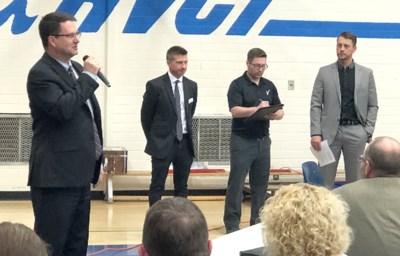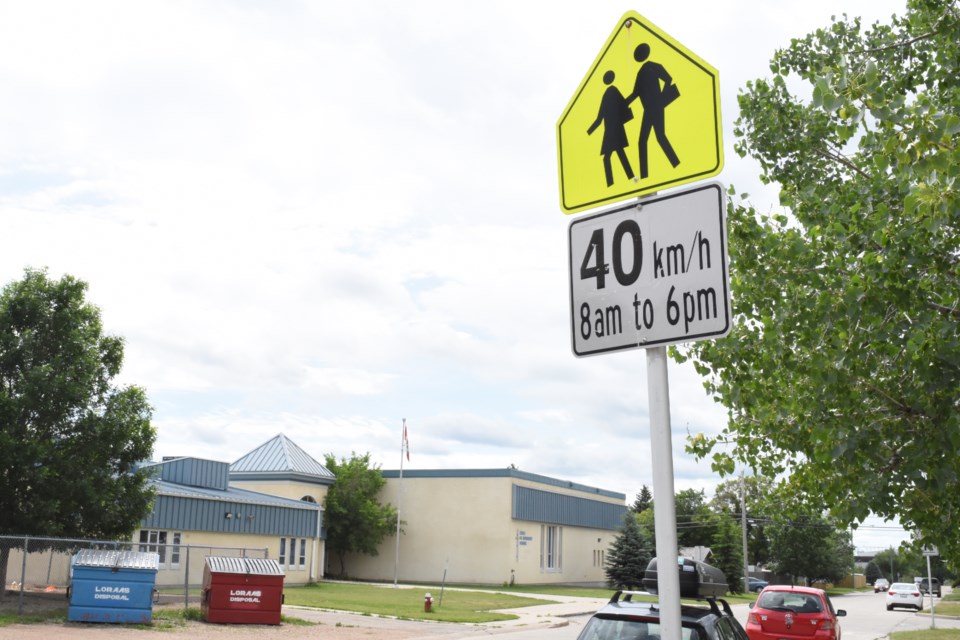The City of Regina recently reduced the speed in its school zones as a safety measure, but officials in Moose Jaw believe there are other ways to keep students safe.
Regina’s city council voted to change the speed in school zones to 30 km/h from 40 km/h, with the speed limit now in effect from 7 a.m. to 7 p.m. instead of 8 a.m. to 10 p.m.
An assessment was performed in two Regina school zones, which identified 1,242 risky behaviours by motorists and pedestrians before and after school. The behaviours ranged from stopping violations and unsafe drop-off and pickup practices, to speeding, not stopping at stop signs and texting while driving.
In Moose Jaw, school zones are in effect from 8 a.m. to 6 p.m. every day of the year, with all speeds set at 40 km/h.
Prairie South School Division
 Prairie South School Division director of education Tony Baldwin addresses the crowd as Holy Trinity Catholic School Division director of education Sean Chase, Holy Trinity board chair Derek Hassan and Prairie South board chair Tim McLeod look on. Photo by Randy Palmer
Prairie South School Division director of education Tony Baldwin addresses the crowd as Holy Trinity Catholic School Division director of education Sean Chase, Holy Trinity board chair Derek Hassan and Prairie South board chair Tim McLeod look on. Photo by Randy PalmerParking near schools is the main problem PSSD faces in Moose Jaw, he continued. The three schools with the worst parking are Westmount Elementary on Currie Crescent, Palliser Heights on Simpson Avenue, and King George on Fifth Avenue Northwest.
Baldwin is thankful for the patience that residents of Currie Crescent have since that street “has a terrible setup as far as parking.” Palliser Heights is the biggest elementary school in the division, so delivering and picking up students poses a challenge, while Fifth Avenue Northwest is a narrow street that is congested since Saskatchewan Polytechnic is nearby.
The division has encouraged parents to be “very, very careful” when picking up and dropping off their children, Baldwin said.
He explained that the division regularly works with students on safety issues, including around traffic. Since many children live with a one-kilometre walking radius, it’s a normal practice to teach them how to safely navigate streets.
The installation of speed enforcement cameras near William Grayson and Palliser Heights was not a PSSD decision, the education director pointed out. He was unsure if those cameras contributed to motorists driving more slowly. However, whether there are cameras or not, the division does not have a concern about excessive speeds in any of its school zones.
Holy Trinity Catholic School Division
Sean Chase, director of education for Holy Trinity Catholic School Divison, explained the division is okay with the current speed limits.
“As it stands right now, we have not received any type of study or feedback from those in charge to suggest a change is necessary,” he said. The division’s greater concern, he continued, is looking after the safety of its students before and after school, along with providing safety training to its bus drivers.
Holy Trinity would be respectful of, and co-operative with, any report that city council produced to determine if a change is required, said Chase. Meanwhile, the division regularly communicates with its administrators, community councils and school resource officers about safety.
Some specific measures the division takes include enhancing parking and traffic signage, improving the safe progression of buses in and out of school zones, and using control pylons. Schools also work with students to teach them how to safely manage high-congested areas, whether they walk, bike or take the bus, at any time of year.
There are no speed enforcement cameras in any Catholic school zones; those devices are out of Holy Trinity’s jurisdiction, said Chase. However, if the municipality deemed the cameras to be an effective way to control speed, the division would support anything that reduced risk factors in those areas.
Moose Jaw Police Service
The Moose Jaw Police Service pays close attention to school zones and takes their safety seriously, explained Sgt. Kevin Pillsworth, media spokesman with the MJPS.
“In general terms, when people do reduce their speed, it gives them more stopping time (and) it allows drivers to identify hazards and risky situations,” he said. “Reducing speed can be a positive thing. But … it is a complex situation.”
The service does encourage changes that make traffic flows safer, if those changes are evidence-based, Pillsworth continued. With the recent school zone adjustments in Regina, that could encourage another review in Moose Jaw.
“Is there a major push (here)? I’m not sure,” Pillsworth said, adding an assessment would have to be completed to determine the advantages and disadvantages of reducing school zone speeds.
The decision to decrease those speeds is not up to the police service, however, but is up to city council, he added. The Transportation Safety Advisory Committee (TSAC) would have to bring forward a recommendation to council if it thought changes were warranted.
 City of Moose Jaw
City of Moose Jaw
TSAC has undertaken a review of Moose Jaw’s Traffic Bylaw during the last year-and-a-half and has suggested some changes, explained Coun. Chris Warren, the committee’s city council representative.
The committee is composed of members from the police, city council, city hall, both school divisions, and residents.
There were some discussions about school zones’ speeds, but the committee decided not to make changes since members did not see any major issues to address, he continued.
Instead, conversations focused on school zone safety, particularly, the use of bus stop arms, educating the public about those devices, and ensuring “our tiniest of citizens” are as safe as possible, Warren explained. Other discussions focused on enhancing signage, upgrading crosswalks, ensuring traffic flows were appropriate, and ensuring there are suitable loading and unloading zones.
One recommendation TSAC recently sent to council — and that was approved — was for city administration to work with the police and both school divisions to promote safety in those school zones and create more awareness for motorists who drive through.
“I have not had any input or feedback about the (suitability of the) 40 km/h (speed limit),” Warren said. “Our community is generally satisfied with that.”
Speed enforcement cameras have been set up in two school zones in Moose Jaw since at least 2016. Having those cameras in place is a good thing, Warren said, since they are tools to enhance safety.
“I am open to more discussions about more cameras if the province wants to do so,” he remarked, adding motorists should slow down in school zones and watch for children every day of the year.




